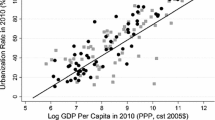Abstract
In analyzing the disparities in regional employment growth in Germany, in the recent empirical literature the so called shift-share-regression models are frequently applied. However, these models usually neglect spatial interdependencies, even though such interdependencies are likely to occur on a regional level. Therefore, this paper focuses on the importance of spatial dependencies using spatial autocorrelation in order to analyze regional employment growth. Spatial dependency in the form of spatial lag, spatial error, and cross regressive models are compared. The results indicate that the exogenous variables’ spatial lag sufficiently explains the spatial autocorrelation of regional employment growth.
Similar content being viewed by others
References
Appelbaum E, Schettkat R (1993) Employment developments in industrialized economies: explaining common and diverging trends. Discussion paper FS I 93-313. Berlin, Wissenschaftszentrum Berlin für Sozialforschung
Appelbaum E, Schettkat R (1994) The end of full employment? On economic development in industrialized countries. Intereconomics 29(3):122–130
Appelbaum E, Schettkat R (2001) Are prices unimportant? The changing structure of the industrialized economies. In: Ten Raa T, Schettkat R (eds) The growth of service industries. Edward Elgar, Cheltenham, pp 121–131
Bauer T (1998) Arbeitsmarkteffekte der Migration und der Einwanderungspolitik. Physica-Verlag, Heidelberg
Blanchflower DG, Oswald AJ (1994) The wage curve. MIT Press, Cambridge
Blien U, Maierhofer E, Vollkommer D, Wolf K (2003) Einflussfaktoren der Entwicklung ostdeutscher Regionen. Theorie, Daten, Deskriptionen und quantitative Analysen. In: Blien U (ed) Die Entwicklung der ostdeutschen Regionen. Beiträge zur Arbeitsmarkt- und Berufsforschung, vol 267. Institut für Arbeitsmarkt- und Berufsforschung, Nürnberg, pp 67–254
Blien U, Suedekum J, Wolf K (2005) Local employment growth in West Germany: a dynamic panel approach. IZA discussion paper No 1723
Blien U, Wolf K (2002) Regional development of employment in eastern Germany: an analysis with an econometric analogue to shift-share techniques. Pap Reg Sci 81:391–414
Chiswick BR (1982) The impact of immigration on the level and distribution of economic well-being. In: Chiswick BR (ed) The gateway—US immigration issues and politics. American Enterprise Institute for Public Policy Research, Washington, pp 289–313
DESTATIS (2009a) Bruttoinlandsprodukt, Bruttowertschöpfung in den kreisfreien Städten und Landkreisen Deutschlands 1992 und 1994 bis 2007 – Ser 2, vol 1. Statistical offices of the federation and the Länder
DESTATIS (2009b) Erwerbstätige in den kreisfreien Städten und Landkreisen der Bundesrepublik Deutschland 1991 bis 2007 – Ser 2, vol 1. Statistical offices of the federation and the Länder
DESTATIS (2009c) Monatsbericht: Betriebe im Verarbeitenden Gewerbe: Betriebe, Beschäftigte nach Betriebsgrößenklassen – Stichtag: 30.09. – regionale Tiefe: Kreise und krfr. Städte (bis 2002). Statistical offices of the federation and the Länder, regional data base, excerpt from 2009/15/10
Eckey H-F, Kosfeld R, Türck M (2006) Abgrenzung deutscher Arbeitsmarktregionen, Volkswirtschaftliche Diskussionsbeiträge Nr 81/06. Institut für Volkswirtschaftslehre Universität Kassel, Kassel
Federal Employment Agency (2009) Statistics of the federal employment agency: special statistical evaluation
Florax R, Folmer H (1992) Specification and estimation of spatial linear regression models. Reg Sci Urban Econ 22:405–432
Fox J, Monette G (1992) Generalized collinearity diagnostics. J Am Stat Assoc 87(417)178–183:
Franz W (2006) Arbeitsmarktökonomik, 6th edn. Springer, Berlin
Jerger J, Michaelis J (2003) Wage hikes as supply and demand shock. Metroeconomica 54(4):434–457
Johnston J, DiNardo J (1996) Econometric methods, 4th edn. McGraw-Hill/Irwin, New York
Keilbach M (2000) Spatial knowledge spillovers and the dynamics of agglomeration and regional growth. Physica-Verlag, Heidelberg
Klotz S, Pfeiffer F, Pohlmeier W (1999) Zur Wirkung des technischen Fortschritts auf die Qualifikationsstruktur der Beschäftigung und die Entlohnung. Jahrb Natlökon Stat 291(1+2):90–108
Kosfeld R, Dreger C (2006) Thresholds for employment and unemployment: a spatial analysis of German regional labour markets, 1992–2000. Pap Reg Sci 85(4):523–542
Kosfeld R, Eckey H-F, Lauridsen J (2008) Disparities in prices and income across German NUTS 3 Regions. Appl Econ Q 54(2):123–141
Möller J, Tassinopoulos A (2000) Zunehmende Spezialisierung oder Strukturkonvergenz? Eine Analyse der sektoralen Beschäftigungsentwicklung auf regionaler Ebene. Jahrb Reg wiss 20:1–38
Niebuhr A (2000) Räumliche Wachstumszusammenhänge – Empirische Befunde für Deutschland. HWWA discussion paper 84
Niebuhr A (2003) Spatial interaction and regional unemployment in Europe. Eur J Spat Dev 5:1–26
Nijkamp P, Poot J (1998) Spatial perspectives on new theories of economic growth. Ann Reg Sci 32:7–37
Overman HG, Puga D (2002) Unemployment clusters across Europe’s regions and countries. Econ Policy 39:115–147
Patterson MG (1991) A note on the formulation of a full-analogue regression model of the shift-share method. J Reg Sci 31(2):211–216
Romer PM (1990) Endogenous technological change. J Polit Econ 98(5):S71–S102
RRG (2009) RRG GIS Datenbasis. Reisezeitenmatrizen zwischen NUTS-3 Regionen in der Europäischen Union: Pkw, Lkw, Bahn, Schiff und Flugzeug. Büro für Raumforschung, Raumplanung und Geoinformation. Oldenburg i.H.: RRG. http://www.brrg.de/database.php?language=de
Schanne N (2006) Employment growth in German regions—a spatial econometric approach. Paper prepared for spatial econometrics workshop, Rome 2006
Suedekum J, Blien U (2004) Wages and employment growth: disaggregated evidence for West Germany. IZA discussion paper No 1128
Suedekum J, Blien U (2007) Stimulating employment growth with higher wages? A new approach to addressing and old controversy. Kyklos 60(3):441–464
Suedekum J, Blien U, Ludsteck J (2006) What has caused regional employment growth differences in Eastern Germany? Jahrb Reg wiss 26:51–73
Author information
Authors and Affiliations
Corresponding author
Rights and permissions
About this article
Cite this article
Zierahn, U. The importance of spatial autocorrelation for regional employment growth in Germany. Jahrb Reg wiss 32, 19–43 (2012). https://doi.org/10.1007/s10037-011-0062-x
Accepted:
Published:
Issue Date:
DOI: https://doi.org/10.1007/s10037-011-0062-x




